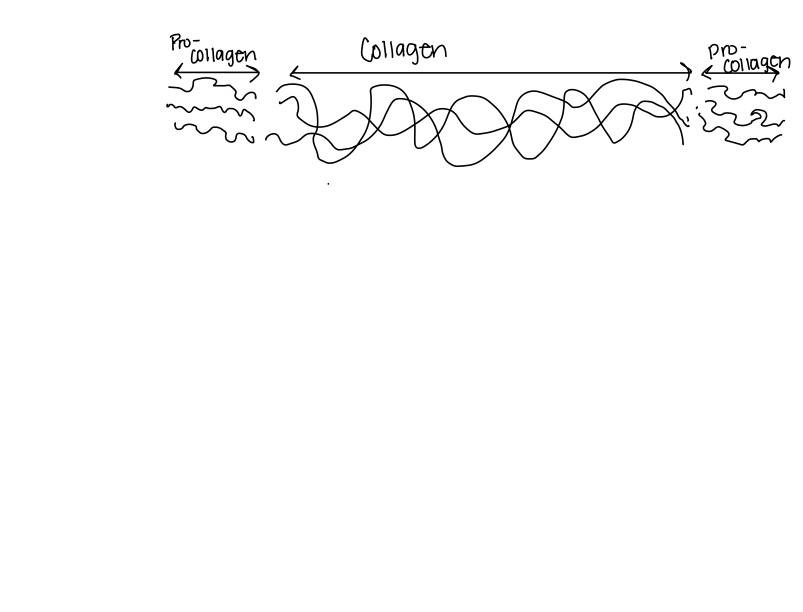A squamous cell carcinoma (SCC) also known as cutaneous squamous cell carcinoma (CSCC) is the most common type of skin cancer. Roughly around 1.8 million people each year are diagnosis each year in the US. (The Skin Cancer Foundation, n.d.). Squamous cell carcinoma starts as squamous cells in the outer most layers of the epidermis, and is caused by the overproduction of squamous cells in the epidermis. This type of skin cancer can also be caused by high exposure to ultraviolet lights or rays or exposure to chemicals; such as cigarettes, the sun, and tanning beds. This one of the biggest reasons why it is extremely important to where sunscreen when being exposed to the sun or other UV lighting for long periods of time. Squamous cell carcinoma also forms in areas of the body where there is mucous membranes, such as mouth, lungs, and anus .(Cleveland Clinic, 2022).
Collagen III ( or Collagen type III) is a fibrillar, thread like structure, collagen which consist of one a chain in comparison to the other collagens. It is also a homotrimer ( a protein composed of three identical units of polypeptides. (Wikipedia, 2023)) containing three alpha 1 chains that supercoil around each other creating a right- handed triple helix. (Nielsen and Karsdal, 2016). Collagen III has a lot of functions, but its most important function is its interactions with the platelets in blood clotting. It is also a signaling molecule in wound healing. Collagen III is also said the be expressed in early embryos and throughout embryogenesis. In adults, collagen iii is a major component of the extracellular matrix in a variety of our internal organs and our skin. In a couple of studies researchers have linked the mutation of collagen iii to be a cause of type iv Ehlers- Danlos syndrome. (Liu et al., 1997), which is a group of inherited disorders that mostly affects the skin, joints, and blood vessels. (Mayo Clinic, 2017).

There has been some research to understand the relationship collagen iii and cancer. For example, there was a study done to show the relationship between collagen iii and breast cancer. Collagen III aided breast cancer in multiple different ways in this study. In the tumor collagen type iii was a component in regulating myofibroblast differentiation. It also regulated the tumors progression in the tumors microenvironment by suppressing metastasis- promoting characteristics. (Brisson et al., 2015). Collagen III along with Collagen I are potential aids in cell migration meaning they could potentially help cancer cells spread throughout the body. (Graf et al., 2021).
Figure one showed the changes in proliferative tumor cells and dormant tumor cells. In figure one it shows that proliferative tumor cells range in a lot more colors than dormant cells. It is also shown that the proliferative tumor cells are more organized than dormant cells. Proliferative tumor cells are more linear whereas dormant tumor cells are more mesh-like. These changes are also consistent with what is seen in single cells versus metastases. Single cells are more linear and organized, and metastases are more mesh like. Also shown in figure two, in the top left box, there are more metastases seen than single cells in any of the boxes in figure two.
These changes are also relevant in the cell cycle. There are three phases in the cell cycle G0/ G1, S, and G2. Dormant cells mostly stay in G0/ G1 phase, and their nucleus appear bright green. Where cells in the phase S appear to be bright green all over, and cells in the phase G2 appear to have a bright green nucleus and dispersed green throughout their cytoplasm. In the third figure, A and B is a single cell that is dormant and in the phase G0/G1. A.1 and B.1 are both metastases but look completely different. A.1 appear to have more cells in phase G2 than S, whereas B.1 appear to have more cells in S than G2. In pictures C and C.1, it shows that the metastases are more linear, and the single cell is curlier or mesh- like. When pictures A,B, and C are merged, the single cell is mesh- like and there is an overlap or green form picture A and the red from picture B which causes the cell to become yellow. The overlap in colors turning the cell yellow means that cell is primarily in G0/G1. The merge of metastases cells show that they are more linear and appear to be in S and G2 phase.
When researcher conducted a test to see which proteins had the biggest effect on proliferative and dormant cells. I showed that 36% of the protein in proliferative cancers are collagen III, and 55% percent of the protein in dormant cells are collagen III. Collagen III in a proliferative cancer cell looks completely mesh- like, whereas Collagen III in a dormant cells looks mesh- like and linear. Figure four, shows that there is more Collagen III located around the dormant cells than there is around the active or proliferative cancer cells. It also shows that there is more Collagen in the single cells than the metastases cells.
Collagen III has an effect on the growth of the cancerous cells. In the fifth figure, it shows that a mouse was injected with T-Hep3 (proliferative cancer cell) by itself and T-Hep3 with collagen III. The growth of the T-Hep3 tumor was a lot larger than the T-Hep3 with collagen III tumor. In figure six, it shows the rate at which the T-Hep3 that was by itself and the cells of the T-Hep3 with collagen III cells. The rate of T-Hep3 was a lot faster than the collagen III cells. It showed that Collagen III decreases the size of the tumor while also decreasing the number of cancerous cells that go through S/G2.

Leave a Reply